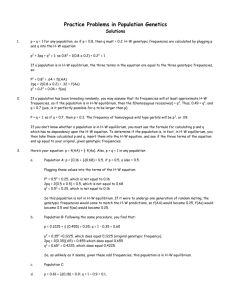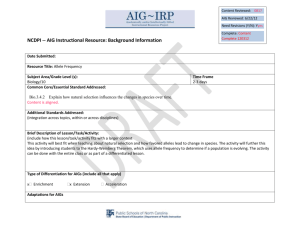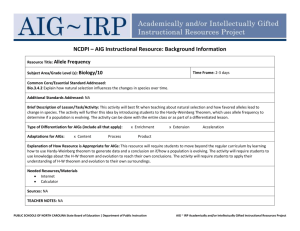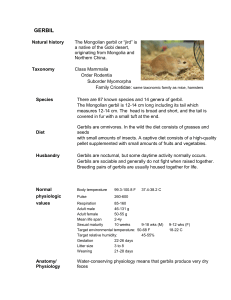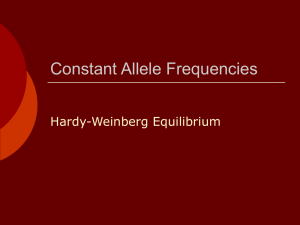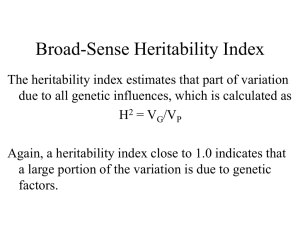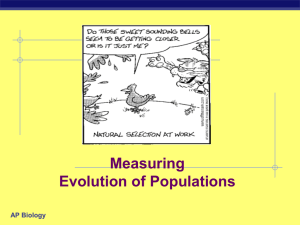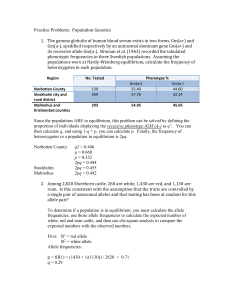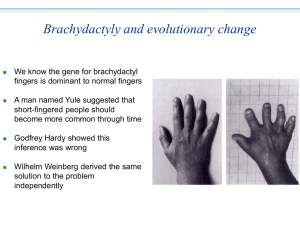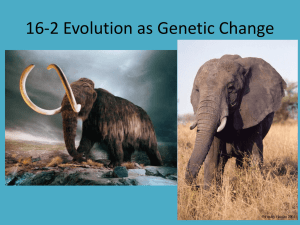Population Genetics Examples
advertisement
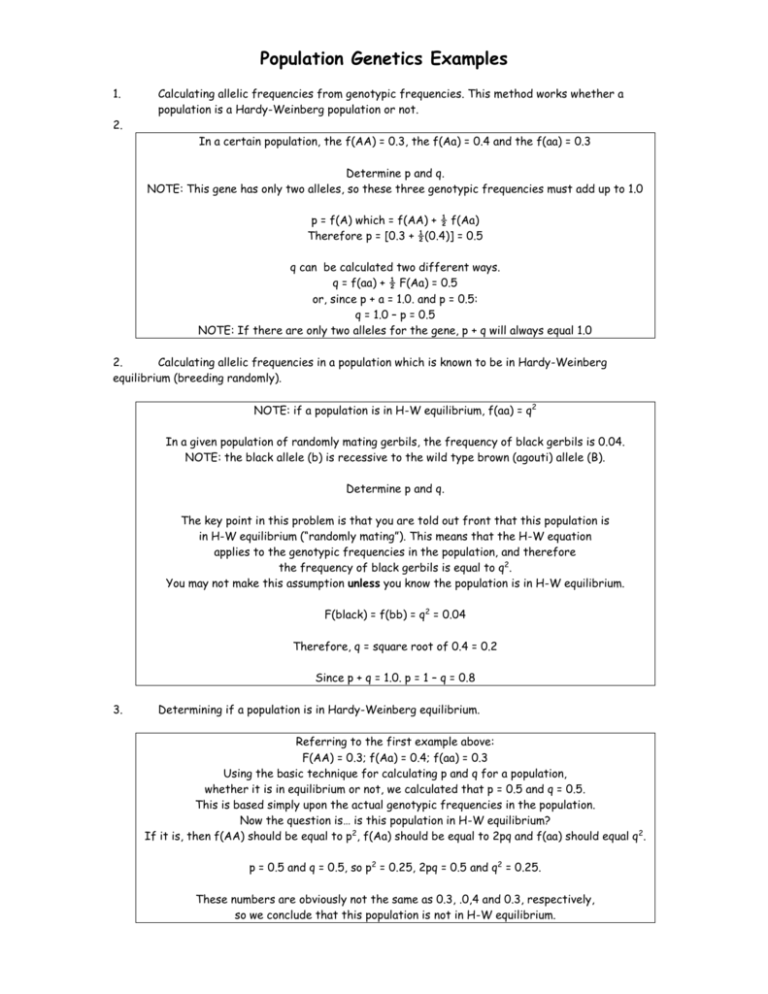
Population Genetics Examples 1. 2. Calculating allelic frequencies from genotypic frequencies. This method works whether a population is a Hardy-Weinberg population or not. In a certain population, the f(AA) = 0.3, the f(Aa) = 0.4 and the f(aa) = 0.3 Determine p and q. NOTE: This gene has only two alleles, so these three genotypic frequencies must add up to 1.0 p = f(A) which = f(AA) + ½ f(Aa) Therefore p = [0.3 + ½(0.4)] = 0.5 q can be calculated two different ways. q = f(aa) + ½ F(Aa) = 0.5 or, since p + a = 1.0. and p = 0.5: q = 1.0 – p = 0.5 NOTE: If there are only two alleles for the gene, p + q will always equal 1.0 2. Calculating allelic frequencies in a population which is known to be in Hardy-Weinberg equilibrium (breeding randomly). NOTE: if a population is in H-W equilibrium, f(aa) = q2 In a given population of randomly mating gerbils, the frequency of black gerbils is 0.04. NOTE: the black allele (b) is recessive to the wild type brown (agouti) allele (B). Determine p and q. The key point in this problem is that you are told out front that this population is in H-W equilibrium (“randomly mating”). This means that the H-W equation applies to the genotypic frequencies in the population, and therefore the frequency of black gerbils is equal to q2. You may not make this assumption unless you know the population is in H-W equilibrium. F(black) = f(bb) = q2 = 0.04 Therefore, q = square root of 0.4 = 0.2 Since p + q = 1.0. p = 1 – q = 0.8 3. Determining if a population is in Hardy-Weinberg equilibrium. Referring to the first example above: F(AA) = 0.3; f(Aa) = 0.4; f(aa) = 0.3 Using the basic technique for calculating p and q for a population, whether it is in equilibrium or not, we calculated that p = 0.5 and q = 0.5. This is based simply upon the actual genotypic frequencies in the population. Now the question is… is this population in H-W equilibrium? If it is, then f(AA) should be equal to p2, f(Aa) should be equal to 2pq and f(aa) should equal q2. p = 0.5 and q = 0.5, so p2 = 0.25, 2pq = 0.5 and q2 = 0.25. These numbers are obviously not the same as 0.3, .0,4 and 0.3, respectively, so we conclude that this population is not in H-W equilibrium. 4. Calculating selection effects. If complete selection occurs against a particular allele, the frequency of that allele can be expected to decrease with each generation. The decrease is contingent upon the frequency of individuals conceived who are homozygous for this allele. In gerbils, there exists a gene which has a lethal allele. In heterozygotes, this allele causes a white spotting color pattern. Homozygotes die as embryos and are never seen in live gerbils. For the purposes of this example, we will assign the symbol “W” to the normal allele of this gene and “w” to the lethal allele. Assume a H-W population which begins with the allelic frequencies p = 0.8 and a = 0.2. We calculate the reduction in q as follows (NOTE: (delta) should be read “change in”), and qo = the original q): q = -(qo2/[1+qo]) (NOTE that q will always be a negative number) q = -0.22/1.2 = -0.033… q1 (new q after one generation of selection) is calculated by adding q to qo (remember that q is a negative number) q1 = 0.2 – 0.03 = 0.17 p1 = 1.0 – q1 = 0.83 In the next generation, assuming the population is breeding randomly, the f(WW) = p12 = .69, so 69% of newly conceived gerbils will be solid; f(Ww) = 2p1q1 = .28, so 28% of newly conceived babies will be spotted; f(ww) = q12 = 0.3, so 3% of newly conceived babies will die as fetuses. NOTE: Actual phenotypic frequency of offspring in a problem like this is tricky. Because the ww babies die, they are never seen in among the actual offspring, and are thus not really part of the phenotypic ratio. A bit of math shows that 71% of living babies will be solid, 29% spotted. NOTE: The official symbols for these two alleles are actually the reverse of what we used here. I did this because the equation used for selection always involves q. 5. Calculating migration effects. In a certain randomly mating gerbil population, 1% of the population has black fur, the rest are wild type agouti (brown). Brown (B) is completely dominant to black (b). Since the population is breeding randomly, we can assume H-W, thus f(black) = q2, and q = square root of f(black). Thus q = 0.1, and p = 0.9. Our population welcomes a group in new gerbils. Among these new gerbils, P = 0.5 and Q = 0.5. The new, migrant gerbils number 20% of the total, combined population. So m = 0.2. q1 = (1-m)qo + mQ q1 = (1-0.2)(0.1) + (0.2)(0.5) = 0.08 + 0.1 = 0.18 So the new, combined q - = 0.18, and the new p = 0.82. These numbers make sense. They are between the original and migrant values, but are closer to the values of the original population, which was the larger contributor to the combined group. New genotypic frequencies would be calculated by plugging p1 and q1 into the H-W equation.
